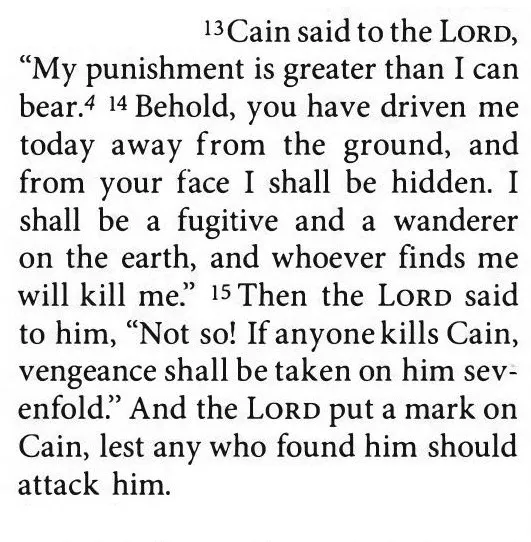Welcome to my DTube Hebrew reading & language series.
The full study is now on line covering the Alef-Beyt here in my blog. This is a beginners program to teach letters, vowels, and reading. The vowels are marked in this bible and are designed to help avoid confusion on what a word is and how it is pronounced. The confusion is obvious in the hundreds of interpretations globally.

Today we are continuing in Genesis 4:13-15

From asking "Am I my brother's keeper?" to feeling the pain of consequences, sent out into the world as the first murderer.
He begged the Creator and told him that he would be killed if he is found. So God put a sign, mark, or letter on him that would tell people not to strike him (down) if he was found. The word "Ote" , spelled alef vav tav, is the same word for "Letter". Ours are A, B, C... The Hebrew "Oteote" (alef-beyt) come from the same word used to "mark" Cain for survival.
When I searched for the 'mark of Cain' there are many that all look the same from a popular Sam and Dean series . They depict it as a Kaf. I wrote the Kaf Sofit (right). The two dots are the vowel shvah. Could that be the mark?
For more information about this letter take a look at my post about it. You will see the mention of blood, which we talked about last week, and the meaning of Kaf in that post.
Was it a letter (Kaf Sofit) on his arm? Did Cain receive a sign of some sort or a mark? If read in English, you will only see that he had a mark, no other option or mental image.
More info is in the video. I talked a bit about Matza, which is the flat bread used in Exodus, and the root letters in Shabbat and "sevenfold" which can be heard easily.
Here is the English interpretation of today's reading to compare.

Try checking the two languages and seeing how the word order changes. In a lot of ways Hebrew is like Latin languages.
Noted in the reading :
*1 Some vocabulary great and sign as indicated in green.
*2 Some examples of direct objects marked liked this --me and --him
- a direct object is the word right after a verb (today they are pronouns; me, you, him, her...)
- these can either be the entire word or just one letter at the end of a word 'one finding him'
- an example in English, Sally met --him (if it were marked the same way)
*3 The name of God usually has one vowel omitted - here it shows them all.
See the difference in the way God's name is written directly below the highlighted one.
Today's reading

This is one of the best ways to learn a language, reading and learning to understand words and word order in Hebrew while reading. Click the links below to hear the reading.
Here are the links
Please click over to DTube and read the above passage with me in Hebrew.
▶️ DTube
▶️ IPFS
Note: my pronunciation of The Name as Yehovah is explained more fully in Genesis 2, DTube Video #2 and the coinciding audio is linked here. - The above reading shows HaShem (the name) clearly with all the vowels where that belong. The ommitted vowel is accentuated.
If you are just starting, my lessons are all here starting at Alef, adding vowels (the dots and lines) as we go, the sofit formations and numerical values. Just go to my blog and scroll to the bottom or click here
Get your Hebrew Bible now!
Click here to obtain the book we are using. It is a free download - or browser usable.
Thanks for taking the time to watch and read.